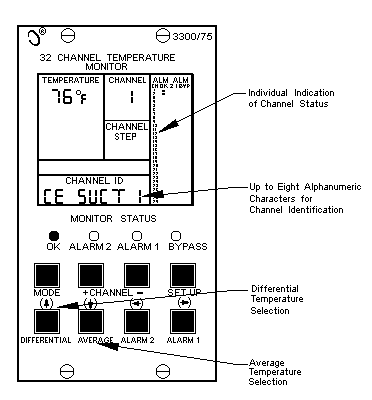Valve Temperature Monitoring using 3300/75 Reciprocating Compressor Valve Temperature Monitors, Resistance Temperature Detectors (RTDs) and Transducer Interface Modules (TIMs)
Suction and discharge valves are the highest maintenance items on a reciprocating compressor. Faulty valves can significantly reduce the efficiency of the compressor. The 32-Channel Valve Temperature Monitor displays the temperatures of the compressor valves and can help you to manage your valuable reciprocating equipment.
During normal process conditions, an increase in the gas temperature near a valve is a primary indication of a failing valve. The Bently Nevada 3300/75 32-Channel Valve Temperature Monitor provides early warning of valve temperature changes and allows the operator to identify the bad valve(s).
Bently Nevada does not recommend that the customers use this parameter to shut down their machine. It is primarily a machinery management tool to help customers determine when to replace piston rings and valves and in determining which valves to replace.
Benefits
The benefits of using the 3300/75 32-channel Valve Temperature Monitor include the ability to:
- Detect bad or damaged valves at an early stage. Bad valves can result in reduced capacity and efficiency and damage to the cylinder liner due to valve parts falling into the cylinder.
- Determine if gas leakage is occurring between the head and crank ends of the piston due to damaged or worn piston rings.
Description of Measurement
By recompressing the same gas, a leaky valve becomes hotter than normal, causing the valve cover plate temperature to increase. Since the normal operating temperature of each valve varies with changes in load, gas stream and ambient temperature, it is necessary to compare the temperatures of similar valves in the same process conditions. Measuring the differential temperature between these valves provides an early and reliable indication of a degrading valve. The 32-Channel Valve Temperature Monitor measures temperature variation of one valve compared to others within its “group.” A typical group can be all the intake valves on the head end of one cylinder, even if some of the valves are equipped with unloaders for regulation of the process. If a valve is unloaded, however, it may effect the temperature of that individual valve and can cause a wide variation in temperature. In these instances, bypass that channel before unloading the valve in order to minimize these effects on the group.
Leaking piston rings will cause the temperature of the entire cylinder to increase through the reworking of gas between each side of the piston. Therefore, detecting changes in absolute valve temperature is also important. If a temperature increase for all valves in the same cylinder is not due to a process change or lubrication problem, it is most likely due to piston ring leakage. Both intake and discharge valves at the head end and crank end will show an increase in temperature due to piston ring leakage. Similarly, a temperature increase for all valves on only the crank end of a cylinder is an indication of leakage in the cylinder packing.
Differential Offset Adjustment
When measuring valve temperatures on reciprocating compressors, the only required adjustment is the differential offset for each channel within the group. This is necessary to set how far from the average temperature each valve can vary before triggering an alarm.
This will make it easier to detect a variation of one valve temperature from the group average. To use this differential offset correctly, the following assumptions apply:
1. The compressor is operating at normal operating temperatures, loads, etc.
2. None of the valves in the group are faulty or unloaded at the time the differential offset adjustment is made.
System Description
Transducer Interface Modules (TIMs) help to minimize wiring from the machine to the 3300/75 32-Channel Valve Temperature Monitor. RTDs and/or thermocouples, in any combination, are connected to TIMs near the machine. Individual TIMs are linked together in a single junction box. A five-conductor shielded cable connects the grouped TIMs in the junction boxes to each other and sends the signal to the monitor. This eliminates the need to route individual cables to the monitor, greatly reducing installation costs of the system.
TIMs are available for both J and K type thermocouples and 100 ohm platinum RTDs. Since each channel is programmed independently, different types of TIMs can be used with a single Valve Temperature Monitor.
Application
The Valve Temperature Monitor needs about one second to scan each channel and approximately thirty seconds to update the monitor if all 32 channels are used. The 32-Channel Temperature Monitor can measure a large number of valve temperatures on reciprocating compressors, making it a cost-effective alternative compared to other temperature monitoring systems. However, it only scans the temperatures on each compressor valve. It should not be used for temperature measurements that are used for machinery protection and which have energized alarm relays to shutdown the machine.

